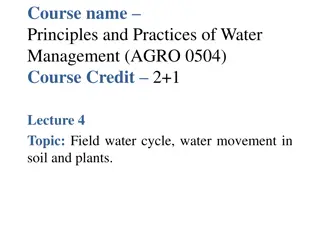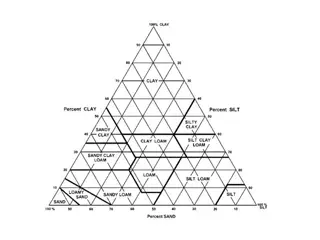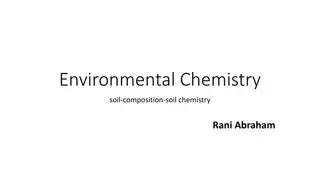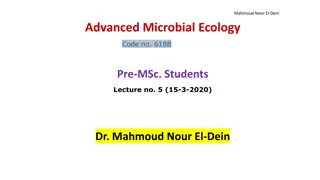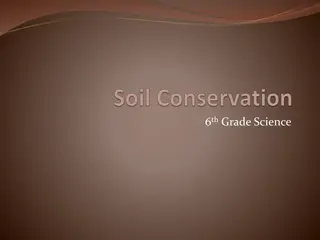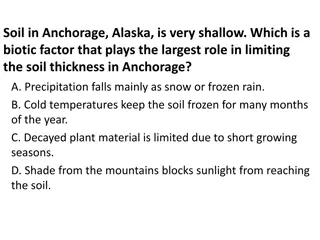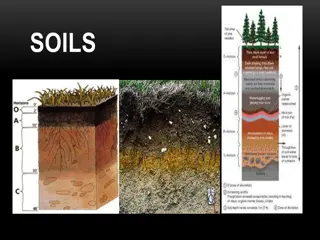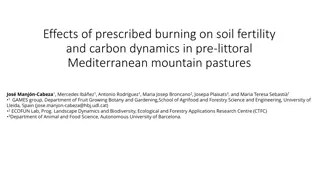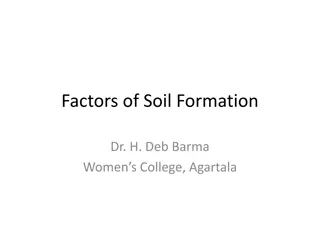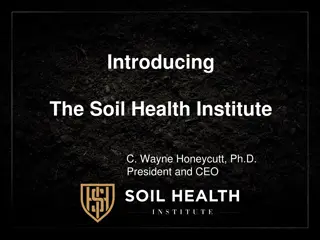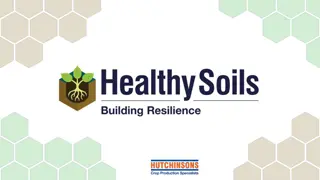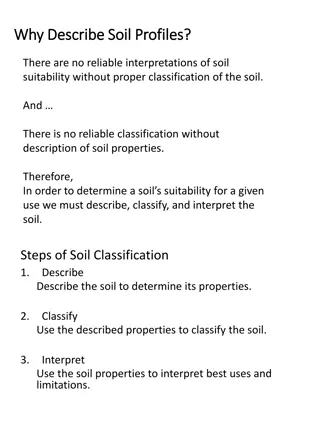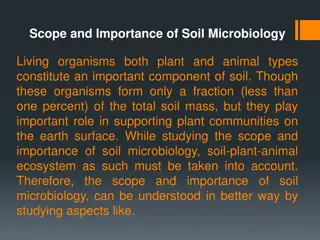The Significance of Soil Ecosystems
Soil is a complex mixture of organic matter, minerals, gases, liquids, and organisms essential for sustaining life on Earth. It plays a crucial role in plant growth, water storage, atmospheric modification, and providing habitats for various organisms. Soil science delves into the composition, development, and impact of soils on ecosystems, highlighting its role in Earth's carbon cycle and response to human activities and climate change. With billions of organisms residing in even a gram of soil, it embodies an immense genetic diversity contributing to the planet's ecosystem health.
Download Presentation

Please find below an Image/Link to download the presentation.
The content on the website is provided AS IS for your information and personal use only. It may not be sold, licensed, or shared on other websites without obtaining consent from the author.If you encounter any issues during the download, it is possible that the publisher has removed the file from their server.
You are allowed to download the files provided on this website for personal or commercial use, subject to the condition that they are used lawfully. All files are the property of their respective owners.
The content on the website is provided AS IS for your information and personal use only. It may not be sold, licensed, or shared on other websites without obtaining consent from the author.
E N D
Presentation Transcript
HEAT TRANSFER IN SOIL HEAT TRANSFER IN SOIL Definition of soil Soil is a mixture of organic matter, minerals, gases, liquids, and organisms that together support life. The Earth's body of soil is the pedosphere, which has four important functions: - 1 it is a medium for plant growth - 2 it is a mean of water storage, supply and purification - 3 it is a modifier of Earth's atmosphere - 4 it is a habitat for organisms all of which, in turn, modify the soil
Soil interfaces with the lithosphere, the hydrosphere, the atmosphere, and the biosphere. Soil consists of - 1 a solid phase of minerals and organic matter (the soil matrix), - 2 a porous phase that holds gases (the soil atmosphere) and water (the soil solution) Accordingly, soils are often treated as a three-state system of solids, liquids, and gases. Soil is a product of the influence of - 1 climate, relief (elevation, orientation, and slope of terrain), organisms - 2 parent materials (original minerals) interacting over time
It continually undergoes development by way of numerous physical, chemical and biological processes, which include weathering with associated erosion. Given its complexity and strong internal connectedness, it is considered an ecosystem by soil ecologists. Soil science has two main branches of the study: - 1 Pathology 2- Pathology. Pathology is concerned with the impact of soil on organisms. Pathology focuses on the composition, description and classification of soil in its natural environment.
Functions of soils Functions of soils Soil is a major component of the Earth's ecosystem. The world's ecosystems are impacted in far-reaching ways by the processes carried out in the soil - 1 from ozone depletion and global warming, to rainforest destruction and water pollution - 2 With respect to Earth's carbon cycle, soil is an important carbon reservoir, and it is potentially one of the most reactive to human disturbance and climate change. As the planet warms, it has been predicted that soils will add carbon dioxide to the atmosphere due to increased biological activity at higher temperatures, a positive feedback (amplification).
Since soil has a tremendous range of available niches and habitats, it contains most of the Earth's genetic diversity. A gram of soil can contain billions of organisms, belonging to thousands of species, mostly microbial and in the main still Soil has a mean prokaryotic density of roughly 108 organisms per gram, whereas the ocean has no more than 107 procaryotic organisms per milliliter (gram) of seawater Organic carbon held in soil is eventually returned to the atmosphere through the process of respiration carried out by heterotrophic organisms, but a substantial part is retained in the soil in the form of soil organic matter; tillage usually increases the rate of soil respiration, leading to the depletion of soil organic matter Since plant roots need oxygen, ventilation is an important characteristic of soil. This ventilation can be accomplished via networks of interconnected soil pores, which also absorb and hold rainwater making it readily available for plant uptake
Since plants need an almost constant supply of many elements and these elements are as follows: - 1 Water, but most areas receive scattered rain, the ability of the soil to retain water is vital for the survival of plants. 2. Effectively remove impurities, kill disease factors, and degradation of pollutants, the latter factor is called natural deflation. 3. The soil usually maintains a net absorption of oxygen and methane, 4. It is subject to a net release of carbon dioxide and nitrous oxide. The soil provides plants with both
- 1 Physical support, air and water, 2-moderate temperature, nutrients, detoxification protection. - 3 Soil provides food readily available to plants and animals by converting dead organic matter into different forms of nutrients Soil Profile: Darkened topsoil and reddish subsoil layers are typical in some regions.



